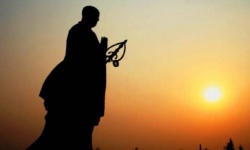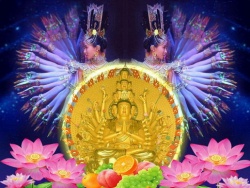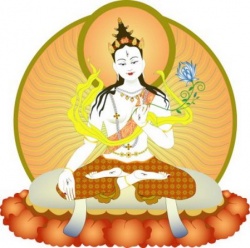Difference between revisions of "The Three Gems"
m (Text replacement - "]]]" to "]])") |
|||
| Line 8: | Line 8: | ||
We are all [[Buddhas]], because only through us can [[understanding]] and [[love]] become {{Wiki|tangible}} and effective. Thich Thanh Van was killed during his [[effort]] to help other [[people]]. He was a good [[Buddhist]], he was a good [[Buddha]], because he was able to help tens of thousands of [[people]], {{Wiki|victims}} of the [[war]]. Because of him, [[awakening]], [[understanding]], and [[love]] were real things. So we can call him a [[Buddha]] [[body]], in [[Sanskrit]] [[Buddhakaya]]. For [[Buddhism]] to be real, there must be a [[Buddhakaya]], [[an embodiment]] of [[awakened]] [[activity]]. Otherwise [[Buddhism]] is just a [[word]]. Thich Thanh Van was a [[Buddhakaya]]. [[Shakyamuni]] was a [[Buddhakaya]]. When we realize [[awakening]], when we are [[understanding]] and [[loving]], each of us is a [[Buddhakaya]]. | We are all [[Buddhas]], because only through us can [[understanding]] and [[love]] become {{Wiki|tangible}} and effective. Thich Thanh Van was killed during his [[effort]] to help other [[people]]. He was a good [[Buddhist]], he was a good [[Buddha]], because he was able to help tens of thousands of [[people]], {{Wiki|victims}} of the [[war]]. Because of him, [[awakening]], [[understanding]], and [[love]] were real things. So we can call him a [[Buddha]] [[body]], in [[Sanskrit]] [[Buddhakaya]]. For [[Buddhism]] to be real, there must be a [[Buddhakaya]], [[an embodiment]] of [[awakened]] [[activity]]. Otherwise [[Buddhism]] is just a [[word]]. Thich Thanh Van was a [[Buddhakaya]]. [[Shakyamuni]] was a [[Buddhakaya]]. When we realize [[awakening]], when we are [[understanding]] and [[loving]], each of us is a [[Buddhakaya]]. | ||
| − | The second [[gem]] is the [[Dharma]]. [[Dharma]] is what the [[Buddha]] taught. It is the way of [[understanding]] and [[love]] - how to understand, how to [[love]], how to make [[understanding]] and [[love]] into real things. Before the [[Buddha]] passed away, he said to his students, "Dear [[people]], my [[physical body]] will not be here tomorrow, but my [[teaching]] [[body]] will always be here to help. You can consider it as your own [[teacher]], a [[teacher]] who never leaves you." That is the [[birth]] of [[Dharmakaya]]. The [[Dharma]] has a [[body]] also, the [[body]] of the [[teaching]], or the [[body]] of the way. As you can see, the meaning of [[Dharmakaya]] is quite simple, although [[people]] in [[Mahayana]] have made it very complicated. [[Dharmakaya]] just means the [[teaching]] of the [[Buddha]], the way to realize [[understanding]] and [[love]]. Later it became something like the {{Wiki|ontological}} [[ground of being]]. | + | The second [[gem]] is the [[Dharma]]. [[Dharma]] is what the [[Buddha]] [[taught]]. It is the way of [[understanding]] and [[love]] - how to understand, how to [[love]], how to make [[understanding]] and [[love]] into real things. Before the [[Buddha]] passed away, he said to his students, "Dear [[people]], my [[physical body]] will not be here tomorrow, but my [[teaching]] [[body]] will always be here to help. You can consider it as your [[own]] [[teacher]], a [[teacher]] who never leaves you." That is the [[birth]] of [[Dharmakaya]]. The [[Dharma]] has a [[body]] also, the [[body]] of the [[teaching]], or the [[body]] of the way. As you can see, the meaning of [[Dharmakaya]] is quite simple, although [[people]] in [[Mahayana]] have made it very complicated. [[Dharmakaya]] just means the [[teaching]] of the [[Buddha]], the way to realize [[understanding]] and [[love]]. Later it became something like the {{Wiki|ontological}} [[ground of being]]. |
| − | Anything that can help you wake up has [[Buddha nature]]. When I am alone and a {{Wiki|bird}} calls me, I return to myself, I breathe, and I [[smile]], and sometimes it calls me once more. I [[smile]] and I say to the {{Wiki|bird}}, "I hear already." Not only {{Wiki|sounds}}, but sights can remind you to return to your [[true self]]. In the morning when you open your window and see the [[light]] streaming in, you can [[recognize]] it as the {{Wiki|voice}} of the [[Dharma]], and it becomes part of the [[Dharmakaya]]. That is why [[people]] who are awake see the [[manifestation]] of the [[Dharma]] in everything. A pebble, a {{Wiki|bamboo}} [[tree]], the cry of a baby, anything can be the {{Wiki|voice}} of the [[Dharma]] calling. We should be able to practice like that. . . . | + | Anything that can help you wake up has [[Buddha nature]]. When I am alone and a {{Wiki|bird}} calls me, I return to myself, I [[breathe]], and I [[smile]], and sometimes it calls me once more. I [[smile]] and I say to the {{Wiki|bird}}, "I hear already." Not only {{Wiki|sounds}}, but sights can remind you to return to your [[true self]]. In the morning when you open your window and see the [[light]] streaming in, you can [[recognize]] it as the {{Wiki|voice}} of the [[Dharma]], and it becomes part of the [[Dharmakaya]]. That is why [[people]] who are awake see the [[manifestation]] of the [[Dharma]] in everything. A pebble, a {{Wiki|bamboo}} [[tree]], the cry of a baby, anything can be the {{Wiki|voice}} of the [[Dharma]] calling. We should be able to practice like that. . . . |
[[Dharmakaya]] is not just expressed in words, in {{Wiki|sounds}}. It can express itself in just being. Sometimes if we don't do anything, we help more than if we do a lot. We call that non-action. It is like the [[calm]] [[person]] on a small boat in a storm. That [[person]] does not have to do much, just be himself, and the situation can change. That is also an aspect of [[Dharmakaya]]: not talking, not [[teaching]], just being. . . . | [[Dharmakaya]] is not just expressed in words, in {{Wiki|sounds}}. It can express itself in just being. Sometimes if we don't do anything, we help more than if we do a lot. We call that non-action. It is like the [[calm]] [[person]] on a small boat in a storm. That [[person]] does not have to do much, just be himself, and the situation can change. That is also an aspect of [[Dharmakaya]]: not talking, not [[teaching]], just being. . . . | ||
| Line 16: | Line 16: | ||
The [[Sangha]] is the {{Wiki|community}} that [[lives]] in [[harmony]] and [[awareness]]. [[Sanghakaya]] is a new [[Sanskrit]] term. | The [[Sangha]] is the {{Wiki|community}} that [[lives]] in [[harmony]] and [[awareness]]. [[Sanghakaya]] is a new [[Sanskrit]] term. | ||
| − | The [[Sangha]] needs a [[body]] also. When you are with your family and you practice smiling, [[breathing]], [[recognizing]] the [[Buddha]] [[body]] in yourself and your children, then your family becomes a [[Sangha]]. If you have a [[bell]] in your home, the [[bell]] becomes part of your [[Sanghakaya]], because the [[bell]] helps you to practice. If you have a cushion, then the cushion also becomes part of the [[Sanghakaya]]). Many things help us practice. The [[air]], for [[breathing]]. If you have a park or a riverbank near your home, you are very [[fortunate]] because you can enjoy practicing [[walking meditation]]. You have to discover your [[Sanghakaya]]-invite a [[friend]] to come and practice with you, have tea [[meditation]], sit with you, join you for [[walking meditation]]. All those efforts are to establish your [[Sanghakaya]] at home. Practice is easier if you have a [[Sanghakaya]]. . . . | + | The [[Sangha]] needs a [[body]] also. When you are with your [[family]] and you practice smiling, [[breathing]], [[recognizing]] the [[Buddha]] [[body]] in yourself and your children, then your [[family]] becomes a [[Sangha]]. If you have a [[bell]] in your home, the [[bell]] becomes part of your [[Sanghakaya]], because the [[bell]] helps you to practice. If you have a cushion, then the cushion also becomes part of the [[Sanghakaya]]). Many things help us practice. The [[air]], for [[breathing]]. If you have a park or a riverbank near your home, you are very [[fortunate]] because you can enjoy practicing [[walking meditation]]. You have to discover your [[Sanghakaya]]-invite a [[friend]] to come and practice with you, have tea [[meditation]], sit with you, join you for [[walking meditation]]. All those efforts are to establish your [[Sanghakaya]] at home. Practice is easier if you have a [[Sanghakaya]]. . . . |
| − | Practicing [[Buddhism]], practicing [[meditation]] is for us to be [[serene]] and [[happy]], [[understanding]] and [[loving]]. In that way we work for the [[peace]] and [[happiness]] of our family and our {{Wiki|society}}. If we look closely, the [[Three Gems]] are actually one. In each of them, the other two are already there. In [[Buddha]], there is [[Buddhahood]], there is the [[Buddha]] [[body]]. In [[Buddha]] there is the [[Dharma body]] because without the [[Dharma body]], he could not have become a [[Buddha]]. In the [[Buddha]] there is the [[Sangha]] [[body]] because he had breakfast with the [[bodhi tree]], with the other [[trees]], and birds and environment. In a [[meditation]] center, we have a [[Sangha]] [[body]], [[Sanghakaya]], because the way of [[understanding]] and [[compassion]] is practiced there. Therefore the [[Dharma body]] is present, the way, the [[teaching]] is present. But the [[teaching]] cannot become real without the [[life]] and [[body]] of each of us. So the [[Buddhakaya]] is also present. If [[Buddha]] and [[Dharma]] are not present, it is not a [[Sangha]]. Without you, the [[Buddha]] is not real, it is just an [[idea]]. | + | Practicing [[Buddhism]], practicing [[meditation]] is for us to be [[serene]] and [[happy]], [[understanding]] and [[loving]]. In that way we work for the [[peace]] and [[happiness]] of our [[family]] and our {{Wiki|society}}. If we look closely, the [[Three Gems]] are actually one. In each of them, the other two are already there. In [[Buddha]], there is [[Buddhahood]], there is the [[Buddha]] [[body]]. In [[Buddha]] there is the [[Dharma body]] because without the [[Dharma body]], he could not have become a [[Buddha]]. In the [[Buddha]] there is the [[Sangha]] [[body]] because he had breakfast with the [[bodhi tree]], with the other [[trees]], and birds and {{Wiki|environment}}. In a [[meditation]] center, we have a [[Sangha]] [[body]], [[Sanghakaya]], because the way of [[understanding]] and [[compassion]] is practiced there. Therefore the [[Dharma body]] is {{Wiki|present}}, the way, the [[teaching]] is {{Wiki|present}}. But the [[teaching]] cannot become real without the [[life]] and [[body]] of each of us. So the [[Buddhakaya]] is also {{Wiki|present}}. If [[Buddha]] and [[Dharma]] are not {{Wiki|present}}, it is not a [[Sangha]]. Without you, the [[Buddha]] is not real, it is just an [[idea]]. |
Without you, the [[Dharma]] cannot be practiced. It has to be practiced by someone. Without each of you, the [[Sangha]] cannot be. That is why when we say, "I [[take refuge]] in the [[Buddha]]," we also hear, "The [[Buddha]] takes [[refuge]] in me." "I [[take refuge]] in the [[Dharma]]. The [[Dharma]] takes [[refuge]] in me. I [[take refuge]] in the [[Sangha]]. The [[Sangha]] takes [[refuge]] in me." | Without you, the [[Dharma]] cannot be practiced. It has to be practiced by someone. Without each of you, the [[Sangha]] cannot be. That is why when we say, "I [[take refuge]] in the [[Buddha]]," we also hear, "The [[Buddha]] takes [[refuge]] in me." "I [[take refuge]] in the [[Dharma]]. The [[Dharma]] takes [[refuge]] in me. I [[take refuge]] in the [[Sangha]]. The [[Sangha]] takes [[refuge]] in me." | ||
Latest revision as of 13:51, 30 March 2024
By Thich Nhat Hanh
WHEN WE SAY, "I take refuge in the Buddha" we should also understand that "The Buddha takes refuge in me," because without the second part the first part is not complete. The Buddha needs us for awakening, understanding, and love to be real things and not just concepts. They must be real things that have real effects on life. Whenever I say, "I take refuge in the Buddha," I hear "Buddha takes refuge in me."
We are all Buddhas, because only through us can understanding and love become tangible and effective. Thich Thanh Van was killed during his effort to help other people. He was a good Buddhist, he was a good Buddha, because he was able to help tens of thousands of people, victims of the war. Because of him, awakening, understanding, and love were real things. So we can call him a Buddha body, in Sanskrit Buddhakaya. For Buddhism to be real, there must be a Buddhakaya, an embodiment of awakened activity. Otherwise Buddhism is just a word. Thich Thanh Van was a Buddhakaya. Shakyamuni was a Buddhakaya. When we realize awakening, when we are understanding and loving, each of us is a Buddhakaya.
The second gem is the Dharma. Dharma is what the Buddha taught. It is the way of understanding and love - how to understand, how to love, how to make understanding and love into real things. Before the Buddha passed away, he said to his students, "Dear people, my physical body will not be here tomorrow, but my teaching body will always be here to help. You can consider it as your own teacher, a teacher who never leaves you." That is the birth of Dharmakaya. The Dharma has a body also, the body of the teaching, or the body of the way. As you can see, the meaning of Dharmakaya is quite simple, although people in Mahayana have made it very complicated. Dharmakaya just means the teaching of the Buddha, the way to realize understanding and love. Later it became something like the ontological ground of being.
Anything that can help you wake up has Buddha nature. When I am alone and a bird calls me, I return to myself, I breathe, and I smile, and sometimes it calls me once more. I smile and I say to the bird, "I hear already." Not only sounds, but sights can remind you to return to your true self. In the morning when you open your window and see the light streaming in, you can recognize it as the voice of the Dharma, and it becomes part of the Dharmakaya. That is why people who are awake see the manifestation of the Dharma in everything. A pebble, a bamboo tree, the cry of a baby, anything can be the voice of the Dharma calling. We should be able to practice like that. . . .
Dharmakaya is not just expressed in words, in sounds. It can express itself in just being. Sometimes if we don't do anything, we help more than if we do a lot. We call that non-action. It is like the calm person on a small boat in a storm. That person does not have to do much, just be himself, and the situation can change. That is also an aspect of Dharmakaya: not talking, not teaching, just being. . . .
The Sangha is the community that lives in harmony and awareness. Sanghakaya is a new Sanskrit term.
The Sangha needs a body also. When you are with your family and you practice smiling, breathing, recognizing the Buddha body in yourself and your children, then your family becomes a Sangha. If you have a bell in your home, the bell becomes part of your Sanghakaya, because the bell helps you to practice. If you have a cushion, then the cushion also becomes part of the Sanghakaya). Many things help us practice. The air, for breathing. If you have a park or a riverbank near your home, you are very fortunate because you can enjoy practicing walking meditation. You have to discover your Sanghakaya-invite a friend to come and practice with you, have tea meditation, sit with you, join you for walking meditation. All those efforts are to establish your Sanghakaya at home. Practice is easier if you have a Sanghakaya. . . .
Practicing Buddhism, practicing meditation is for us to be serene and happy, understanding and loving. In that way we work for the peace and happiness of our family and our society. If we look closely, the Three Gems are actually one. In each of them, the other two are already there. In Buddha, there is Buddhahood, there is the Buddha body. In Buddha there is the Dharma body because without the Dharma body, he could not have become a Buddha. In the Buddha there is the Sangha body because he had breakfast with the bodhi tree, with the other trees, and birds and environment. In a meditation center, we have a Sangha body, Sanghakaya, because the way of understanding and compassion is practiced there. Therefore the Dharma body is present, the way, the teaching is present. But the teaching cannot become real without the life and body of each of us. So the Buddhakaya is also present. If Buddha and Dharma are not present, it is not a Sangha. Without you, the Buddha is not real, it is just an idea.
Without you, the Dharma cannot be practiced. It has to be practiced by someone. Without each of you, the Sangha cannot be. That is why when we say, "I take refuge in the Buddha," we also hear, "The Buddha takes refuge in me." "I take refuge in the Dharma. The Dharma takes refuge in me. I take refuge in the Sangha. The Sangha takes refuge in me."


